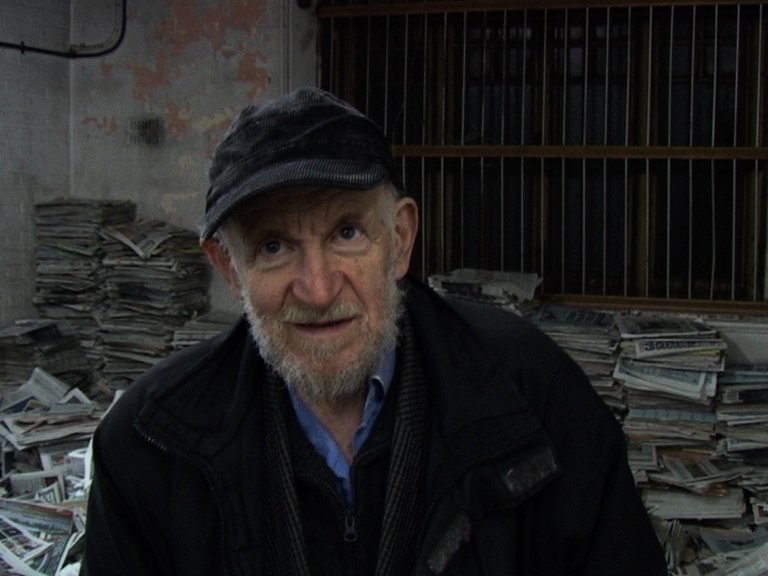Gustav Metzger: 100,000 Newspapers
I was invited to come and film by Wolfe Lenkiewicz, director of the T1+2 Artspace on Wheler Street near Brick Lane, which was hosting the exhibition. At the time, Wolfe and some others used to squat empty factory buildings in the East End, renovate the interiors and use them as studios and living spaces. Bedford House on Wheler Street near Brick Lane was one-such, a large abandoned Victorian building, and the exhibition took place in two adjoining rooms in the basement.
In the first, a huge quantity of newspapers had been piled up on the concrete floor. Gustav had placed five blank canvases against one wall, on which visitors were invited to pin articles and images from the newspapers under the headings Disasters, Extinction, Work, Biotechnology, Information Overload and Supermarkets. This was to be the interactive section. It was here that I started to follow him as he worked, cutting out pieces of paper and walking backwards and forwards to the canvases.
The room next door was a much more threatening space, ringed with banks of metal shelving with an enormous gap in the centre. Over the next three nights, this gap was gradually filled up in a series of performances which Gustav and Wolfe supervised. I looked for nuances in the performances, but participants seemed simply to be dropping individual sheets of newspaper into a dark empty space.
Gustav was a delightful interviewee, happy to be interviewed by a complete stranger, even when he was making final preparations before the exhibition opened. He was sincere and articulate but I couldn’t help feeling that there might be something else going on in addition to his stated intentions. There was something impish about him: was he playing a game or having a joke at our expense? His canvas panels filled up with clippings very slowly and didn’t seem altogether a success. In the forbidding room next door, Gustav and others dropped paper into an empty well, observed by dozens of young artists. Was that it?
When it was empty, I decided to explore the room properly and climbed down to the lower level. This was a dark, claustrophobic space and the further I walked in, the darker it got. The walkway above my head was very low, making it hard to stand up straight and it cast long thin shadows on the shelves below, making them resemble tiny cages or even cells. Arranged either side of a narrow strip of wooden floor, these cells formed a corridor and the newspapers crammed into them now resembled piles of bureaucratic documents. The combination of all the elements made me think of the Holocaust Trains and even the Death Camps.
We can’t know whether any of this was intentional but what is clear is that 100,000 Newspapers was site-specific. To recreate it in another gallery would be simply to miss the point: the artwork was the room. And perhaps this is what Gustav means in the film when he describes it as a found object.
I am very grateful to Nicola Baird and the Ben Uri Gallery for screening the film at an event during their exhibition Becoming Gustav Metzger: Uncovering the Early Years 1945 — 59 earlier this year. Up until then, the film had never been publicly screened.
Martin Pickles
14th November 2021






